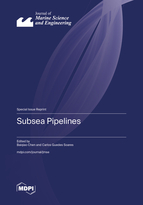Subsea Pipelines
A special issue of Journal of Marine Science and Engineering (ISSN 2077-1312). This special issue belongs to the section "Ocean Engineering".
Deadline for manuscript submissions: closed (1 October 2022) | Viewed by 35583
Special Issue Editors
Interests: marine structure; ocean platform; subsea pipe; corrosion; collision and grounding; ultimate strength; welding; photogrammetry
Special Issues, Collections and Topics in MDPI journals
Interests: marine environment; ship dynamics; marine structures; safety and reliability
Special Issues, Collections and Topics in MDPI journals
Special Issue Information
Dear Colleagues,
A subsea pipeline (also known as an offshore pipeline or submarine pipeline) is a pipeline that is laid on the seabed or inside specially constructed trench. The use of pipelines represents a reliable mode of transport of oil and gas. To prevent failure scenarios, such as improper pressurization, localized buckling, fatigue failure and instability, the limit strength, internal/external pressure, corrosion-resistant material selection, and stability management are main concerns in the design, installation and operation of the submarine pipelines.
This Special Issue will be dedicated to experimental analysis, numerical simulations and analytical solutions related to various aspects of the design and analysis of subsea pipelines. High-quality papers are encouraged for a rapid reviewing process and open-access publication. The topics of interest are listed below:
- Collapse/burst pressure;
- Buckling strength;
- Reliability analysis;
- Corrosion defect and coating;
- Initial imperfections;
- Sandwich pipes;
- Pipe-in-pipe;
- Thermal analysis;
- Design and installation;
- Material characteristics;
- Combined loading condition.
Dr. Carlos Guedes Soares
Guest Editors
Manuscript Submission Information
Manuscripts should be submitted online at www.mdpi.com by registering and logging in to this website. Once you are registered, click here to go to the submission form. Manuscripts can be submitted until the deadline. All submissions that pass pre-check are peer-reviewed. Accepted papers will be published continuously in the journal (as soon as accepted) and will be listed together on the special issue website. Research articles, review articles as well as short communications are invited. For planned papers, a title and short abstract (about 100 words) can be sent to the Editorial Office for announcement on this website.
Submitted manuscripts should not have been published previously, nor be under consideration for publication elsewhere (except conference proceedings papers). All manuscripts are thoroughly refereed through a single-blind peer-review process. A guide for authors and other relevant information for submission of manuscripts is available on the Instructions for Authors page. Journal of Marine Science and Engineering is an international peer-reviewed open access monthly journal published by MDPI.
Please visit the Instructions for Authors page before submitting a manuscript. The Article Processing Charge (APC) for publication in this open access journal is 2600 CHF (Swiss Francs). Submitted papers should be well formatted and use good English. Authors may use MDPI's English editing service prior to publication or during author revisions.
Keywords
- Submarine pipeline
- Strength assessment
- Collapse strength
- Burst pressure
- Buckling
- Corrosion defect
- Reliability
- Experiment
- Finite element analysis
- Composite structure







